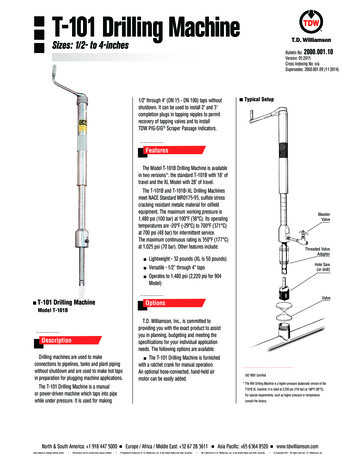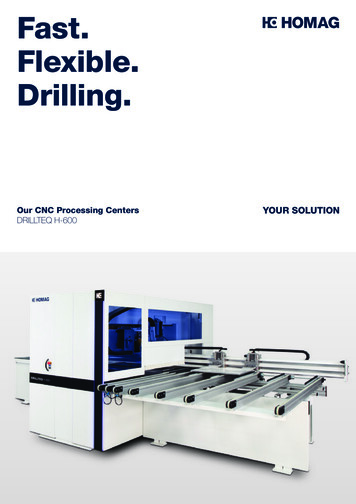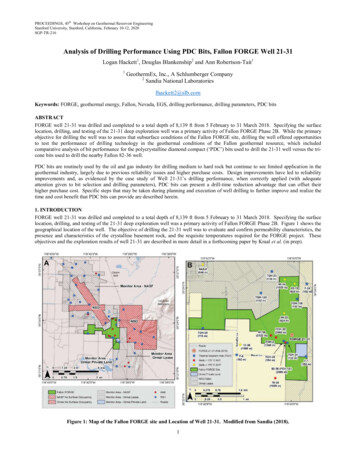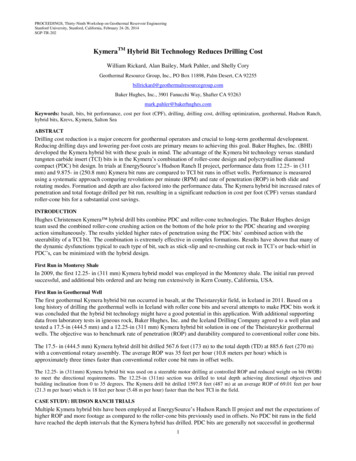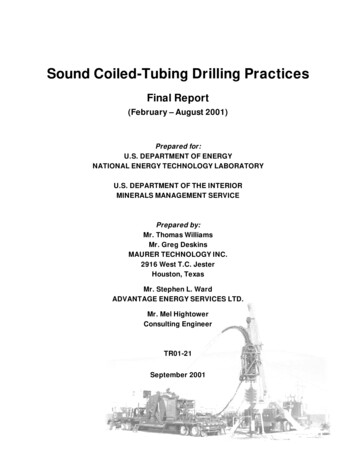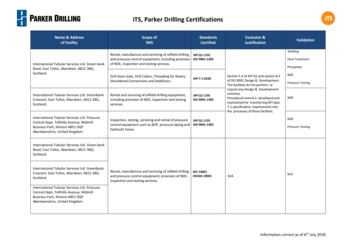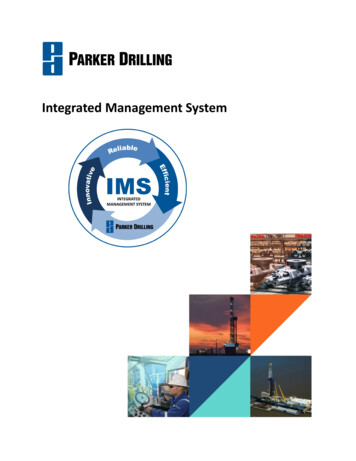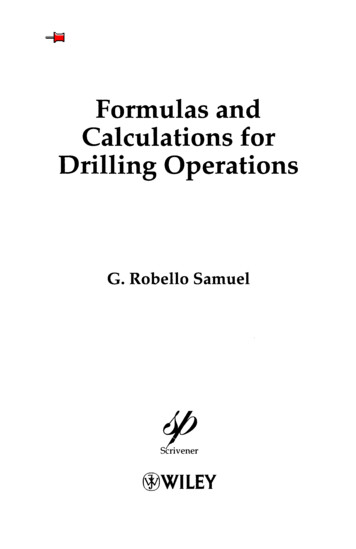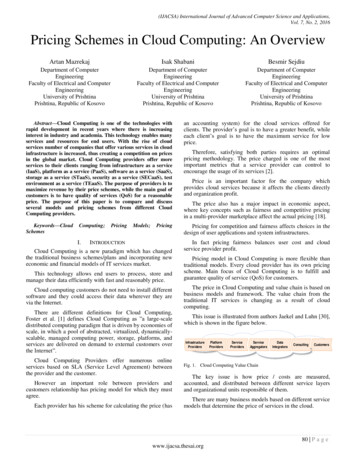
Transcription
UNDERBALANCED DRILLING OVERVIEW"Underbalanced drilling operations reduce the hydrostatic pressure of the drilling fluidcolumn so that the pressure in the wellbore is less than the formation pressure".IntroductionConventional drilling practice calls for maintaining the hydrostatic pressure of the drilling fluidbetween the formation's pore pressure and its fracture pressure. The drilling fluid is continuouslycirculated within the wellbore to control the formation fluids and transport cuttings to the surface.It also works as a stabilizing agent within the wellbore, and lubricates and cools the drill bit. Thefluid is either a water-based or oil-based liquid that varies from 7.8 to 19 pounds per gallon, andcontains a variety of solid and liquid products to impart density, fluid loss characteristics andrheological properties.The conventional practice described above has long been recognized as the safest method fordrilling a well. It does, however, have drawbacks. Since the drilling fluid pressure is higher thanthe natural formation pressure, fluid invasion frequently occurs, causing permeability damage tothe formation. This damage is mainly caused by washout or physical blockage by the intrusion offluids and/or solids into the formation structure.Underbalanced drilling (UBD) is defined as the practice of drilling a well with the wellbore fluidgradient less than the natural formation gradient. It differs from conventional drilling in that thebottomhole circulating pressure is lower than the formation pressure, thereby permitting the wellto flow while drilling proceeds.Figure 1
Besides minimizing lost circulation and increasing the penetration rate, this technique has awidely recognized benefit of minimizing the damage caused by invasion of drilling fluid into theformation. In many UBD applications, additional benefits are seen due to reduction in drilling time,increased bit life, and early detection and dynamic testing of productive intervals while drilling. Itis critical to keep the well underbalanced at all times, if formation damage is to be minimized.Underbalanced drilling technology is a valuable method for minimizing formation invasion relatedproblems. Because the majority of hydrocarbons today are found in existing fields with depletingpressures, or in complex and low quality reservoirs, the economical use of UBD becomes moreand more popular.Most of the underbalanced drilling applications today are conducted through the use of coiledtubing systems. Forty percent of all the onshore wells drilled in the year 2000 were conductedthrough underbalanced conditions. Joint industry projects currently underway off the coast ofBrazil will likely change the conventional drilling practices in offshore applications."Underbalanced drilling technology can save the industry millions of dollars by increasingthe amount of recoverable oil within a shorter time frame".History of Underbalanced DrillingThe concept of drilling with low pressure circulating fluid was first patented in the United States in1866. Early applications used compressed air to drill the hole. As the technology evolved over theyears, gas internal systems with stable foams and aerated fluids were introduced for specificdrilling conditionsthe technique called flow drilling was first developed in South Texas, and became very popularworldwide with early successful applications in Southern Canada, Australia and China. It wasprimarily used for re-development of fields where depleted pressure was an important concern.During the 1990’s, underbalanced drilling was successfully applied in onshore and offshoredrilling operations throughout Europe.Early techniques developed by Angel (1957) and, Moore and Cole (1965) tried to predict thevolume of air or gas required to adequately clean the air-drilled hole. There were also severalattempts published in the literature to develop a systematic design procedure for estimatingwellbore hydraulics in underbalanced drilling applications.
Currently, underbalanced drilling is the most exciting development in the area of drillingengineering.Together with horizontal and multi-lateral drilling techniques, it holds tremendous value for drillingmore cost-effective wells.UNDERBALANCED DRILLING TECHNIQUESUnderbalanced drilling techniques are classified according to density of the fluids used in theprocess. Typical fluid densities range from near 0 to 7 pounds per gallon.In fresh-water applications, the density of the circulating fluid can be reduced by nitrogen gasinjection. This reduced density helps to achieve a bottom hole circulating pressure that is lessthan that of the formation pressure.Even conventional liquids can provide underbalanced conditions with proper density control of thedrilling fluid. On the other hand, it is also possible for a low-density fluid to cause overbalance dueto the frictional pressure drop.Underbalanced drilling has proved to be an economical method for drilling in depleted/lowpressure reservoirs. Since it is possible to record production during drilling, operators can easilyand accurately identify inflow mechanisms and pay intervals, and cease drilling operation as soonas the target zones are identified.One method of controlling the bottomhole pressure (BHP) is to use a choke at the surface. BHPis controlled by opening or closing the choke to lower or raise the standpipe pressure. Since thespeed of a pressure wave through a static fluid column is equal to the speed of sound in thesame medium, a lag time is experienced until the choking action at the surfaces reachesbottomhole. Estimating the lag time in a single-phase system is relatively easy, whereas thesame calculation in multi-phase systems can be quite complicated.Instead of using a choke, the BHP can also be controlled by adjusting the Equivalent CirculatingDensity (ECD). This technique essentially creates an increasing fluid density gradient betweenthe surface and the bottomhole. If the casing is set at a shallower depth, ECD is preferred overchoke pressure control. Since ECD is a function of flow, underbalanced conditions should bepreserved by controlling the hydrostatic head when flow stops during connections.The greater the flow resistance, the higher ECD will be. On the other hand, it can also create anopposing condition when pipe is pulled out of the hole, causing a swabbing effect.
Underbalanced Drilling FluidsThere are three primary types of fluids used in underbalanced drilling operations:oGaseous (Compressible)oTwo-phaseoLiquid (Incompressible)The fluid type is dictated by the boundary conditions of the drilling system. Typically, theboundary conditions are defined by bottomhole flowing pressure, formation fracture pressure,borehole collapse pressure and formation pore pressure. The density range of various drillingfluids is summarized in the following diagram.Figure 2Two different measures are used to define the type of fluid system:oRatio, the gas-to-liquid volume at standard conditions.oQuality, the ratio of gas volume to liquid volume at hole conditions.
Gas-to-liquid ratios of various drilling fluid systems are shown in the following figure.Figure 3Gaseous Drilling FluidsThe oldest and most basic technique is dry air drilling, which involves pumping air down the drillstring and up through the annulus. A rotating wellhead between the blowout preventer and rotarytable is used to divert the returns. The cuttings are sent away from the rig via a discharge pipe,and a water spray is used to kill dust at the outlet. A flame is used to burn any returninghydrocarbons.Nitrogen is another common drilling fluid. Other inert gases are too expensive to be used in thisprocess. A typical method to generate N2 is to use membrane type filters that extract the N2from the air stream before it is pumped into the wellbore.Natural gas is also a drilling fluid option, since it is easily available from pipelines. It can directlybe used without the help of compressors. More information on nitrogen and natural gas drilling isprovided under the "Underbalanced Drilling Methods" subtopic.Circulating pressure and hole cleanup are dependent on each other. More cuttings in the wellbore
cause higher downhole pressures. Angel’s method provides some guidelines regarding air flowrates required for hole cleaning. His charts are still widely used. According to these charts, 3000ft/min is the minimum velocity for effective cutting transport.Two-Phase Drilling FluidsTwo-phase drilling fluids, or lightened drilling fluids, consist of either foam-type fluids or aerateddrilling mud. Liquids are mixed with gas to achieve a required circulating fluid density. Theequation of state method is used to predict fluid properties at downhole conditions.A pump is used to inject liquid into a gas stream before it enters the well. The small liquid dropletsaffect the behavior of the circulating gas. If more liquids (2.5% -25%) are introduced, then a foamphase is generated in which the liquid forms a continuous structure, entrapping the gas bubblesinside.Once the liquid volume exceeds 25%, we no longer have a foam structure. This next levelcomprises aerated drilling muds (fresh water, brine, diesel or crude oil). Parasite strings aretypically used to introduce gas into the circulating liquid stream. A parasite string is an externalflow path (possibly coiled tubing), which is run and cemented outside of the casing.Since gas and liquid compressibility values differ significantly from each other as pressure andtemperature changes, the liquid fraction changes as well. Frictional pressure drops are controlledmainly by the flow regime, flow rate, fluid properties and flow geometry. Therefore, phasebehavior is a very important component in underbalanced drilling models. Many investigators,including a special institute at the University of Tulsa, have extensively analyzed two-phase flowpatterns and regimes. Some of the most common two-phase flow regimes are: Bubble flow Annular dispersed flow Stratified or laminar flow Plug or churn flow Slug flowLiquid Drilling FluidsSince formation pressure is usually larger than the hydrostatic pressure of fresh water or salinewater, conventional drilling fluids might also provide underbalanced conditions. Even if the drillingfluid density exceeds the formation pore gradient, fluid loss into a formation can cause reduced
pressure regions within the wellbore, thus allowing formation fluids to flow in.BENEFITS AND LIMITATIONS OF UNDERBALANCED DRILLINGAdvantagesUnderbalanced drilling offers a number of important benefits:oMaintaining wellbore pressure below the reservoir pressure allows reservoirfluids to enter the wellbore, thus avoiding formation damage. Since significantformation damage is avoided, the stimulation requirements during wellcompletion are also reduced, leading to considerable savings.oDuring underbalanced drilling there is no physical mechanism to force drillingfluid into the formation drilled. Therefore, lost circulation is kept to a minimumwhen fractured or high permeability zones are encountered.oDrilling underbalanced can help in detecting potential hydrocarbon zones, evenidentifying zones that would have been bypassed with conventional drillingmethods.oDue to the decreased pressure at the bit head, UBD operations demonstratesuperior penetration rates compared to conventional drilling techniques. Alongwith reduced drilling times, an increase in bit life is typically reported.oSince there is no filter cake around the wellbore wall, the chances of differentialsticking are also reduced.oSince conventional drilling fluids are not used in underbalanced drillingapplications, there is no need to worry about disposing potentially hazardousdrilling mud.A combination of all these factors can significantly improve the economics of drilling a well. UBDis often preferred if it reduces formation damage and hole problems, and reduces the cost ofstimulation in fractured or moderate/high permeability formations. Moreover, with good mudlogging and drilling records, UBD can provide valuable Formation Evaluation data.DisadvantagesUnderbalanced drilling also has disadvantages that can prove detrimental to the outcome of thedrilling process:oThere is a higher risk of blowout, fire or explosion.
oUnderbalanced drilling is still an expensive technology. Depending on the drillingfluid used, the cost can be significant, particularly for extended reach horizontalwells.oIt is not always possible to maintain a continuously underbalanced condition.Since there is not a filter cake around the wellbore, any instantaneous pulse ofoverbalance might cause severe damage to the unprotected formation.oUBD has its own unique damage mechanisms, such as surface damage of theformation due the lack of heat conduction capacity of underbalanced drillingfluids.oIt is more complicated to model and predict the behavior of compressible drillingfluids.Hole Cleaning ConsiderationsDecreased bottom hole pressure typically causes higher penetration rates. However, higherpenetration rates can increase the circulating bottom hole pressure and bring the well back tooverbalanced conditions. Moreover, due to the annular fluid segregation, there is an increasedrisk that the wellbore will pack-off, resulting in stuck pipe. In this situation, gas tends to rise whilethe liquid settles to the bottom of the hole. This is a major cause of increased bottom holepressures because of the increased fluid density at the sand face.Large cutting volumes generated by high penetration rates are also difficult to remove. Therefore,penetration rates should be carefully adjusted to ensure sufficient hole cleaning and slug removal.Inadequate liquid flow rates can cause sticky-hole conditions that result in differential sticking. Adecrease in ROP would therefore be needed for the cuttings to be transferred to the surface. Aviscosified aqueous phase is an important factor in achieving better ROP.When drilling with fo
Instead of using a choke, the BHP can also be controlled by adjusting the Equivalent Circulating Density (ECD). This technique essentially creates an increasing fluid density gradient between the surface and the bottomhole. If the casing is set at a shallower depth, ECD is preferred over choke pressure control. Since ECD is a function of flow, underbalanced conditions should be preserved by .
